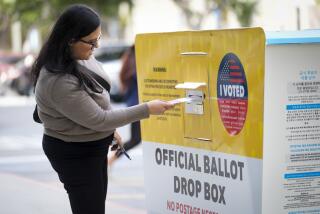New Central S.D. Library a Low Priority
- Share via
SAN DIEGO — Presaging a potentially difficult battle for Mayor Maureen O’Connor in her effort to create a “storybook” bayfront library, most San Diegans see a new central library as a relatively low civic priority and do not favor a downtown location, a Los Angeles Times Poll shows.
Other obstacles facing O’Connor include public opposition to using new taxes to build and operate a new library, and the fact that two-thirds of San Diegans did not use the downtown library even once during the past year, according to the poll.
Nearly two-thirds of San Diegans also are satisfied with the overall quality of the city’s library system, creating yet another hurdle to developing a public mandate for a major initiative to upgrade it.
In last week’s State of the City address, O’Connor underscored how significantly her year-old proposal to build a new central library on Lane Field downtown figures into her own vision of her political legacy. She pledged to personally donate at least $1 million to the project and predicted that ground will be broken within a year.
The poll makes it clear, however, that few San Diegans share O’Connor’s zeal for development of a high-tech library and cultural center on Lane Field, located kitty-corner to the downtown cruise ship terminal on the Embarcadero.
Twice as many people--50%--agree that the city needs a new central library as disagree, with the remaining 25% undecided.
Nevertheless, when San Diegans were asked to name a municipal service or program requiring more attention from the city, the library project lagged far behind issues such as homelessness, police staffing, economic development and drug- and crime-prevention programs.
In fact, 41% of those interviewed listed the library proposal at or near the bottom of the city’s priorities, more than twice as many as the 17% who ranked it at or near the top.
Reiterating that point, many San Diegans expressed reluctance about public funds being used for the construction or operation of a new central library. The “most important factor to consider in planning” a new central library, 43% of those polled said, is that it not be a financial burden to taxpayers, and 59% of the respondents oppose the idea of a new tax to be used solely for that purpose.
Given a choice of where a new central library should be located in the city, San Diegans prefer Mission Valley over downtown by a narrow margin. However, when asked specifically about the Lane Field property preferred by O’Connor, San Diegans opposed the mayor’s choice by a 2-1 margin, 62% to 31%.
“This is in line with what I’ve been hearing since the (Lane Field) idea came up a year ago,” said San Diego Unified Port District Commissioner Dan Larsen, who opposes the mayor’s plan. “It just doesn’t make good economic sense to use public money on something the public isn’t very enthused about.”
O’Connor herself, however, was described by a top City Hall aide as “very heartened” by the poll’s findings.
The 2-1 margin by which the public recognizes the need for a new central library, O’Connor press secretary Paul Downey contended, “certainly creates a mandate” for her proposal, though he conceded that “more selling and educating needs to be done” about what the mayor views as the advantages of the Lane Field site.
The Times Poll was based on telephone interviews conducted Sunday and Monday of 537 adults in the city of San Diego. The margin of sampling error is plus or minus 5 percentage points.
San Diegans’ attitudes about the library perhaps have been shaped by their limited use of the library system in general and the central downtown facility in particular.
Sixty-eight percent of those polled said that neither they nor any other members of their immediate families had visited the downtown library within the past year, with another 21% saying they had used it no more than five times. While 32% of the respondents said they had used the branch libraries 11 or more times during the same period, 31% did so on five or fewer occasions, and 26% did not use the branches.
Among people with children, 40% were frequent visitors to branch libraries last year who used those facilities more than 10 times, while only 8% of those in such households went to the downtown facility that often. Eighty-two percent of San Diegans with children visited a branch at least once last year, contrasted with 33% at the downtown library.
Despite the infrequent use of the downtown facility, San Diegans agreed, by a 50%-25% margin, that the city needs a new central library. Most believe, however, that many more-pressing demands face the city.
Twenty-two percent of those polled identified homeless programs as the municipal service most deserving of more attention from the city, followed by police (20%), jobs and economic development (12%) and drug- and crime-prevention programs (12%). In contrast, only 1% of the respondents cited the library.
Asked to measure a new central library project against “everything (else) that needs to be done by the city,” only 17% characterized the library as a top priority, with 41% placing it at the bottom of the city’s agenda and 38% in the middle.
Accordingly, San Diegans displayed considerable skepticism toward the use of public funds to build or operate a new central library.
The poll showed that a plurality of San Diegans feel the single most important factor to consider in planning a new library is that it “not be a financial burden to the taxpayers,” followed closely by its placement in an accessible location, matters cited by 43% and 39% of the respondents, respectively. Only 12% saw the need for the “most modern facilities” as the most crucial planning consideration.
In addition, San Diegans, by a 59%-34% margin, said they are inclined to oppose any new tax devoted specifically to construction and operation of a new central library. To date, O’Connor has not proposed any such tax, saying she plans to solicit private donations to minimize public expenditures on the estimated $70- to $90-million Lane Field project, if it is approved.
Beyond those financial concerns, O’Connor will also have to surmount strong public opposition to the Lane Field site itself if a new downtown library is to be built there, the poll shows.
By a 40%-32% margin, San Diegans said they would prefer Mission Valley over downtown as the locale for a new library, with another 7% expressing a preference for a North City site. Given an either-or choice between Lane Field and Mission Valley, San Diegans favored Mission Valley by a much wider margin, 65%-26%.
O’Connor and other proponents of Lane Field argue that its advantages include the fact that it is on Port District land that the city could obtain almost free, that two trolley lines and bus lines provide easy access, and that an architecturally distinctive facility could lure more residents and tourists downtown.
Opponents, meanwhile, note that downtown is remote from the city’s population centers and believe that Lane Field would be better suited for a park or cruise ship terminal, and that parking and freeway access would be limited.
An explanation of those pros and cons of the Lane Field proposal does little to convince most San Diegans of its merits, the poll revealed. After each of those arguments was recited to interviewees, they opposed Lane Field by a 2-1 gap, 62% to 31%.
O’Connor spokesman Downey, however, said the mayor believes that “closer examination of the Lane Field-versus-Mission Valley choice” will eventually draw public support to the downtown site.
“The key issue is availability,” Downey said. “The point is that Lane Field is available now for maybe $1 a year, but a Mission Valley site is an unknown that could cost . . . millions of dollars. Time, economics and accessibility favor Lane Field.”
However, Port Commissioner Larsen, whose agency would have to approve the Lane Field project, stressed that officials in the state attorney general’s office and State Lands Commission are still researching the legality of using the waterfront property for that purpose.
As O’Connor lobbies for the Lane Field site, Times Poll Director John Brennan explained, “she’s going to have to do it on the basis of cheapness and accessibility.”
“That could be a foothold for her in trying to sway public opinion,” Brennan said.
Others at City Hall, meanwhile, are less sanguine about what the poll reveals about O’Connor’s chances of gaining approval of the Lane Field library before leaving office in December.
“The public’s attitude--and the council’s own concerns and priorities--almost precludes seeing significant dollars being spent on this for the foreseeable future,” City Councilman Ron Roberts said. “I wouldn’t underestimate the mayor, but this is one time no one’s going to accuse her of being afraid to tackle a tough issue.”
Times Poll
If you had to name one municipal service or project that needs more attention from the city of San Diego, what would it be? Is there another one? (Up to two replies accepted) Homeless programs: 22% Police: 20% Drug and crime prevention: 12% Jobs, economic development: 12% Street repairs: 8% Trolley expansion: 5% Water: 5% Education: 4% Jails: 4% Public transportation: 3% Sewage: 3% Parks: 2% New airport: 2% Medical services for the poor: 2% AIDS services: 2% Library: 1% Recreation programs: 1% Child care: 1% Growth: 1% Affordable housing: 1% More courts: 1% Other: 17% Don’t know: 14%
What part of the city would you most prefer as the site for a new central library: downtown, Mission Valley, North City, the southern part of the city or the eastern part? Mission Valley: 40% Downtown: 32% North City: 7% Don’t know: 7% Eastern San Diego: 6% Southern San Diego: 5% Other: 3%
Have you or a member of your immediate family visited the central library or one of the neighborhood branches during the past year? Visited branch only: 48% Visited both: 25% Visited neither: 20% Visited central library only: 7% Source: Los Angeles Times Poll interviewed 537 adult residents of the city of San Diego
How the Poll Was Conducted
The Los Angeles Times Poll interviewed 537 adult residents of the city of San Diego by telephone Jan. 12-13. Telephone numbers were selected from a list that includes all telephone exchanges in the county. Random-digit dialing techniques were used to ensure that both listed and unlisted telephone numbers had an opportunity to be contacted. Interviewing was conducted in either English or Spanish. The results were adjusted slightly to conform with census figures on variables such as sex, race and national origin, age, education and household size. The margin of sampling error for percentages based on the total sample is plus or minus 5 percentage points. For certain subgroups the error margin is somewhat higher. Poll results can be affected by other factors, such as variations in question wording and the order of question presentation.
More to Read
Sign up for Essential California
The most important California stories and recommendations in your inbox every morning.
You may occasionally receive promotional content from the Los Angeles Times.










